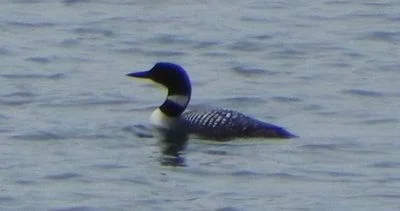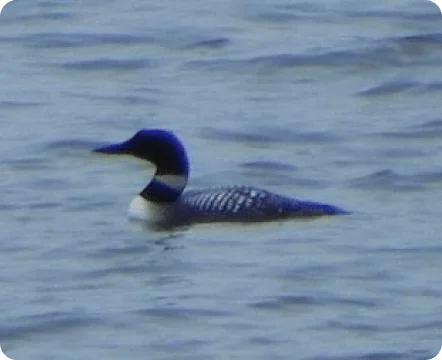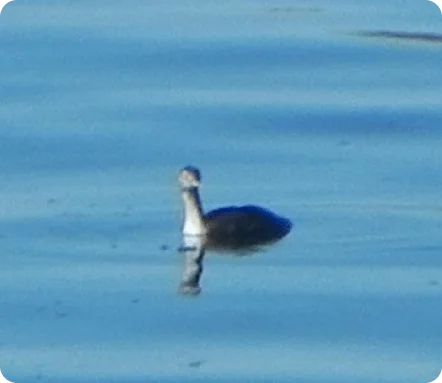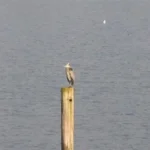Bird Essays
Mostly I have recorded current observations in my postings. I have also written extensive essays on some of the ducks or at least accumulated the history of my observations of them over the years. These essays are gathered here for your more serious reading pleasure.
Great Blue Heron
Great Blue Herons are my favorite bird, what, I think, got me into bird watching. The first heron I met lived in the lagoon behind our family cabin on Whidbey Island. We called him Mr.
Hickenlooper. I have been watching herons there for about 50 years now. They present such a serene image. They are easy to spot since they are so motionless most of the time, except for the occasional dart of their head to spear a fish. I see them everywhere. They not only live in bays but can be seen in rivers, creeks, fields. My most recent interesting sighting was on the Colorado River. I was riding the train through the Rockies following the Colorado River. A beautiful Heron was perched on a rock in the middle of the river in a narrow canyon.
Great Blue Herons, or Ardea herodias, are part of the long-legged waders group. Although they are classified as ‘waders’ what really characterizes these birds is their long bills. They are often called storks or cranes. Cranes are actually ‘marsh birds’ and part of the order of gruiformes, but ornithologists continue to argue about their classifications and differences. * There are other kinds of herons including the Egret, Bittern and Night Heron. We do not see Egrets this far north, but I always enjoy seeing them when traveling to California. I saw Night Herons once when visiting a friend in Denver. But none of the long-legged wading birds are as spectacular as the Great Blue Heron. Herons are about 4 feet tall and have a 6 foot wing span. Despite their size they are not heavy and easily support themselves with only slightly webbed feet.
These days I am blessed to live on Henderson Bay in Gig Harbor, WA. My greatest treat is to wake each morning and watch Mr. Hickenlooper fishing in my front yard. I have taken many pictures of herons over the years, but this is always a challenge. Despite some beautiful markings, especially their white plumes, they blend in with their surroundings. They are also very, very shy. Even opening the door a crack to stick a camera out scares them away. Herons do not know about kyaks though and I have gotten very close to many of them while boating. Floating up next to them is one thing, raising up a camera is another and immediately scares them off. I guess they just don’t like to be photographed. I have managed to have my camera ready a few times. My best memory of doing this was in the lake at the base of the Mendenhall Glacier in Juneau, AK. I guess they can eventually become acclimated to people. I go to Lopez Island each summer and camp on Spencer Spit. There is a large lagoon at the base of the spit with resident herons. You can walk quite close to them along a beach path there.
Mostly Herons are loners and appear to be annoyed when another heron approaches. They rise up, squaaak, and flap their huge wings to shoo off the intruder. I often see a pair out in the bay but they keep their distance.
This summer in the lagoon at Whidbey there are 10 to 15 herons fishing and they seem not to mind being close to others. Recently I sat on a log near the entrance to the lagoon as the tide was receding. I was thrilled to watch a heron parade as they all wandered out of the lagoon. Their walk is very distinctive and fun to watch. What appears to be a knee bending backwards is really their heel. Their knee is tucked up under their feathers. The heel evolved up their legs to assist them in balance by raising their center of balance. It also gives them a spring in their step to help in taking flight much like a sprinter using a heel thrust to spring from the blocks. * (Jake, take notice!) Watching such a large bird take off and fly is always an amazing sight. They slowly flap those huge wings and tend to glide right on the surface of the water.
Perhaps the most amazing thing these big birds do is hang out in trees. They kind of back pedal with their big wings and flap down on pretty small branches. I frequently walk out my back door and flush them out of the trees. It is always a bit startling to hear that squaaak and see that big flapping of wings.
Herons also build nests in trees for mating. Even though they are loners otherwise, they are classified as colonial birds because they nest in groups called rookeries. I saw my first rockery on a birding trip with my sister-in-law in Bolinas outside San Francisco. Audubon Canyon Ranch is a bird sanctuary to preserve this rookery. We were allowed to sneak up a trail and almost look down on the nests. It was amazing. I was surprised a few years later to find out about and to see two rookeries very close to civilization. One is on the Mercer Slough in Bellevue. It is just across the Slough from an office park and can be seen from the parking lots! Another is just off a busy freeway where Highway 18 meets Highway 167 near Auburn, WA. Each has many nests and lots of activity and seem not be be bothered by their neighbors. Because they are such loners, Herons have minimal courting rituals. They gather together in the Rockeries often after migrating together and quickly pair up. The male develops distinctive plumage which is the only time the male and female look different. There is some posturing by the male that includes ‘stretching’. He lifts his head to straight up to display his plumes. The female responds with her own stretch. The male also contributes sticks to the new nest. They take turns fishing to provide food for the hatched young.*
The most surprising thing is their squaaak, squaaak, squaaak sounds. You would expect such a noise to come from some pre-historic creature and not this beautiful bird. I especially like to listen for these sounds after dark. In fact Herons are prehistoric. They are one of the oldest birds. They have survived because they have few enemies. Actually man is their worst enemy. In the early 1900’s their plumes became demanded for ladies hats. It is estimated that 100,000 to 200,000 birds were killed by bounty hunters. Eventually the public outcry became loud enough to stop this practice. In fact, the U.S. Audubon Society was formed at this time specifically to stop the slaughter of herons and egrets. *
Herons are very patient and will stand totally still watching for fish forever and then just when you think they have gone to sleep they will dart down and grab the fish. They swallow it whole and you can see the bulge going down their long neck. Herons can actually see under water. They have ‘monocular’ eyes, meaning that each eye operates independently of the other. Their eyes are placed far enough back on their heads that they can without much movement actually see 360 degrees. * I guess that is why it is so difficult to sneak up on them.
Scientists have had trouble tracking herons. That long beak prevents them from attaching tracking devices. But it is believed that Herons live up to 20 years.*
In parts of their range where food is not available in the winter, Great Blue Herons are migratory, and some may migrate to Washington from points farther north. Most of Washington’s breeding population remains in the state year round. **
We are indeed blessed to have such a magnificant year round resident. Even after 50 years, each heron sight or sound gives me great pleasure.
Mergansers
Mergansers are very attractive ducks especially when you see 100 of them at once. I have been intrigued by Mergansers for many years. I have had many varied encounters with them that have been among the highlights of my birdwatching experiences. As I look back and research these great ducks, I am discovering that I have been seeing 3 different kinds of mergansers. All have very distinct topnots and the males are different but each very striking in appearance. But all three have similar females with brown ‘crowns’. I think this similarity combined with the difficulty of ever getting very close to them has caused me to confuse the three kinds of mergansers. This post will clear up this matter!

Since I have been living on Henderson Bay I have been treated to many spectacular Red Breasted Merganser, Mergus serrator, parades. I have seen 30 to as many as 100 mergansers floating by a number of times. My sources report that these mergansers migrate in groups but not in rafts. A raft must really be a big group of birds.
I have seen the Merganser parades on March 17 (’95), March 20 (’94), March 30 (’92), April 4 (’96), April 11 (’04), April 21 (’02), and April (’05). I also see them in the Fall: Sept 23 (’00), Sept 27 (’03), Sept (’04), Oct 2 (’98) , Oct 3 (’99), Oct 5 (’02) Oct 22 (’95). They are, of course, migrating south in the Fall and on their way back up north in the spring. But I have not seen them in between these dates so they pass through quickly during March and April and Sept and October.
I have seen a few mergansers at a time 5 times over the years always in January. I reported these in my notes as Hooded Mergansers but research says Hooded Mergansers are fresh water ducks so I guess they were also Red Breasted Mergansers or else they were attracked to the creek that flows into my bay nearby.
I think my first memorable encounters came years ago while kyaking in the summers up north around Vancouver Island and Desolation Sound. We would frequently see a large group of ducks ahead and as we approached they would all attempt to fly away. They apparently are not strong flyers because they would all flutter as if walking on the water for a long distance before becoming airbourne. They also kind of screeched while doing this. They would land a short distance away and repeat the act as we approached again. So, I have many memories of kyaking with mergansers running on the water ahead of me. These are the same Red Breasted Mergansers that I see here migrating through in the Fall and Spring. They spent the summers up north. I have also seen them in small groups many times in the winter in the lagoon behind my Whidbey cabin.
Another memorable encounter has been seeing mergansers on rivers. One summer while camping at Staircase in Olympic National park along side the Skykomish River we watched a mother and 6 or 8 young mergansers playing in the water. I have seen them on the Dosewalips River also. This is the Common Merganser, Mercus mergagnser, common in name only. It is here all year round and prefers freshwater rivers and lakes near forests.
Mergansers are unique among ducks because of a long thin beak with serrated edges to grab their slimy prey.
The third kind of merganser is also a fresh water duck, the Hooded Merganser, Lophadytes cucullatus. The most spectacular looking, this is the the one Alison photgraphed on Lake Washington. Small groups of these ducks live year round on fresh water throughout Puget Sound. It is the most agile of the mergansers and can flush directly from the water. I now realize I have rarely seen this merganser. I intend to look more deliberately for it.
All of the Mergansers are spectacular to see and fun to watch parading by, trying to fly, feeding the young or generally just showing off their beautiful colors.
Sources:
Hooded Merganser Photo by Alison Wysong
Cornell Web Site
Seattle Aububon Web Site
Nehls, Harry B, Familiar Birds of the Northwest, Portland Aububon Society
Fisher, Chris C, Birds of Seattle, 1996 Lone Line Publishing
The Audubon Society Field Guide to North American Birds
The Audubon Society Master Guide to Birding, Loons to Sandpipers
Loons
Common Loon


I was watching a beautiful Common Loon this morning and later while working outside I heard it singing. The Loon is the most elegant of ducks, gliding gracefully along in its striking black and white breeding plumage.
I have been seeing loons for about a week now. They are regular and frequent visitors in April, stopping by on their way north. I also see them often in September and October. I have reported seeing loons in Dec, Jan, Feb, and March. Of course one of the most beautiful things about loons is their singing. I have reported loon calls with many of my sightings. It is always a special treat.
Loons are short to mid distance, high latitude migrators mostly building nests in Canada. I have read that non breeding immature loons often remain here all year and some mature loons spend the winter months in Puget Sound. I have seen loons often during the summer kyaking in Canada, off the coast of British Columbia. Once while navigating a narrow channel between islands in Malispina Inlet, I came upon a loon with 3 babies on her back! I had another memorable experience with a loon in Ross lake, just south of the Canadadian border. I was watching some loons in the distance and just sat quietly in my kyak as they dove and came closer. Finally one surfaced very close to me and started singing. I could see his beak opening and closing as he sang.
I almost always see solitary loons but on one occasion in April, 1997, I saw a group of 12. I have reported groups of 6 twice, once in April , 1993 and once in September 1997 and I have one sighting of 3 loons together. I have read that loons fish alone but gather in groups at night. I guess I have caught them a few times before they have headed out to fish.
There are 5 species of loons, but we only see the Common Loon, Gavia immer, here. Its appearance is anything but common. The contrasting black and white coloring is usually only a breeding plumage, but many retain these feathers into the winter. Usually they are more gray and white in the winter. The sexes look alike. Loons are also immediately recognizable by their unique shape. They have a long, sleek body with a thick neck and sharp bill. Loons are actually quite heavy because they are the only duck with solid bones! Loons dive frequently and seem to stay under water for a very long time immerging quite a distance from where they started. Research reveals that they are great swimmers using both wings and feet allowing them to dive as deep as 200 feet. Their legs are so far back on their bodies that they are unable to walk on land and must push along on their chests.
Loons and their beautiful calls are among the most appreciated aspects of bird watching. It is interesting that loons are the first ducks presented in every bird guide I consulted. They are certainly one of my most favorite ducks and have given me many, many moments of pleasure.
Sources:
National Geographic Complete Birds of North America
Fisher, Chris, Birds of Seattle
Nehls, Harry, Familiar Birds of the Northwest
Seattle Audubon Society Web Page
Grebes
Grebes

Grebes are among the most attractive and most fun to watch ducks. From the elegant Western Grebes to the ghostly Horned Grebes to the comical Pie Billed Grebes, these ducks are always entertaining.
The Western Grebe, Aechmophorus occidentalis, has been one of my very favorite ducks for many years. They are large ducks, immediately recognizable by their long thin white neck and small head. They are regular, though diminishing in numbers, visitors to my waterfront. In recent days there have been about a dozen coasting back and forth. When I first moved here I would seen huge flocks of them. I see them mostly in the Fall, Sept and most of October. I have seen them as early as August 13. I once saw a big group in February, 1992. I reported diminishing numbers beginning in 1999. One of my top duck experiences occurred October 16, 1991. I was kyaking out in the middle of the bay at sunset to enjoy the red colors reflected in the water. I saw a huge group of over 50 Western Grebes approaching. I stopped and remained very still as the whole group drifted by on all sides of me. They make funny little noises which are usually hard to hear clearly. It was a great thrill to see them up close and personal.
Western Grebes are very shy and one rarely gets a close up view of them. Once years ago I was sitting quietly on my dock on Lake Washington when a Western Grebe surfaced right next to me. I saw a big grebe catch a big fish in Oct, 1992 close to my bulkhead. But usually I see these ducks through binoculars.
I was lucky to encounter nesting Western Grebes once while kyaking in Denton Slough on Lake Pend Orielle near Sandpoint, Idaho. They build nests on the top of the water supported by water lillies, grasses, etc. We saw about a dozen nests each tended by an adult Western Grebe.
Recently I have also regularly seen a pair of Horned Grebes, Podiceps auritus. They are slightly smaller than the Western Grebe but also have long thin necks. This Grebe is similar to the Earred Grebe. But the Earred Grebe is rare in this area so one can assume they are seeing the Horned Grebe. They are common during the winter and seldom seen in summer. Grebes seldom fly but are great swimmers and the Horned Grebe kind of leaps up before diving.
The third Grebe often see here is the Pied-Billed Grebe, Podilymbus podiceps. They are smaller still and much more drab appearing. There is a distinctive band on their bill. These Grebes prefer fresh water and can be seen year round on lakes and ponds in Puget Sound. They are also fun divers to watch.
I hope whatever is threatening the Western Grebe population can be addressed. I already miss the big flocks and would really miss seeing at least some of them each Fall.

